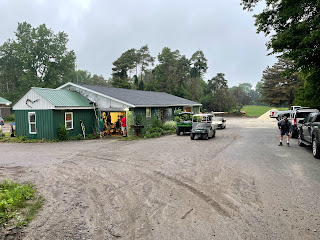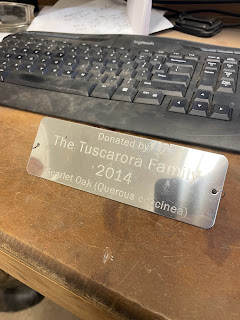Making Hay
With the amazing weather pattern we've enjoyed for over a month we're seeing another year of extended golfing conditions and excellent working weather. Leaf drop is almost over as we wait for the oaks and some of the maples to let go. We appreciate you bearing with us as we try to keep up with leaf work - it seems never-ending and an extra challenge working temporarily short-handed.
Not all that glitters is green
Last year we got lucky as many courses in our region suffered extensive winter damage through no fault of their own and some escaped without a scratch, again, through primarily good luck. There's some correlation with how high greens were mowed going into winter (too low-too late increases damage) but it's anecdotal evidence for now. Unfortunately without a real crystal ball we get to wait to see what's in store and hope for a colder than normal, no-thaw winter.
New Digs
It's been there a while...judging from aerial photography from the 1930's the original shop looks like it's been standing on or near the same foundation for around 85+ years. It's served its purpose dutifully and was adequate for what was required of it.
Tuscarora's history is rich in character and lore. As the club was finally able to purchase the land and have a hand in their destiny, improvements flourished, and they still do. The latest of these 'upgrades' coming on-line in spring 2023 is a turf care facility that can truly be called state-of-the-art.
Remember those awesome practice mats for the range we ordered in February? It's been an experience this year dealing with it and trying not to blame the company for things out of their control. If you're in manufacturing, or a distributor for a manufacturer who's dealing with supply chain and labor issues - hats off to you. It's supremely frustrating to have folks completely prepared only to have to tell them there's yet another delay. Our latest update from this company was 'before Christmas' after postponing three separate times through the season. Hope is we'll have them by opening day in 2023. Fingers crossed.
A Wormy Situation
It's far and away the worst attribute of the property. Of any disease, weed, insect, or winter injury - worm casts are the final boss. It's sparked debate over grass type, mowing schedules, height of cut, and management acumen. The list of remedies from the course across town, or the self-proclaimed turf expert who likes to give their opinion seems never-ending and it's all well intentioned. What I've settled on for the time being is a solution that I'm certain works and works universally. Namely it's mowing when the turf is dry. It's the way forward.
Other plans are using some new growth regulators during the wormy seasons to reduce the need to mow as often. This lessens the smearing that the mowers do which is where the cycle of damage starts. It also gives the fairways a tighter denser canopy that can improve the ball lie in spite of the castings. Notice the difference in the picture below of turf treated from 200 yards in on #5. It has a slightly different color and texture than turf from 200+
We're going to find a solution for this problem without resorting to measures that are unsustainable if not vaguely illegal. The talk of bentgrass fairways isn't dead, but there's much more to be discussed and prepared for before we embark on that voyage.
In the interim, there's a mechanical fix here that will be explored. It's affordable, safe, and sustainable without resorting to chemically nuking the worms from orbit.
Platform Change
The grounds department doesn't have a big social media footprint by design. We keep it impersonal and drama-free because nobody needs that. We try to provide information on all things turf and golf course adjacent, especially relating to Tuscarora. As twitter goes through whatever its going through I decided to take the account over to Instagram for good. The sharing and production tools are better and I hope the engagement and usability is too. As the curator of the account I wanted something that's more attractive to use and experience.
Without opining on twitters latest foibles it's enough said that we have a new social media home for the Tuscarora Grounds Dept. on Instagram @tuscaroragroundsdept
https://instagram.com/tuscaroragroundsdept?igshid=YmMyMTA2M2Y=
Please visit us, interact, and don't hesitate to DM us for any burning questions about why greens are slow, omg who cut the pins, why people won't fix ballmarks, and whether DeeDee ever gets tired.




























